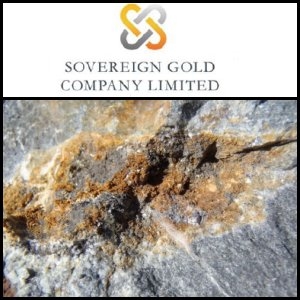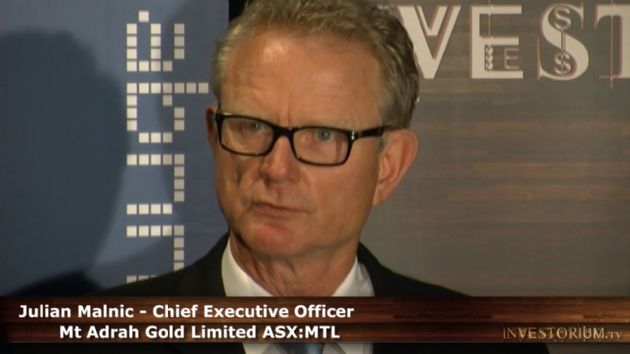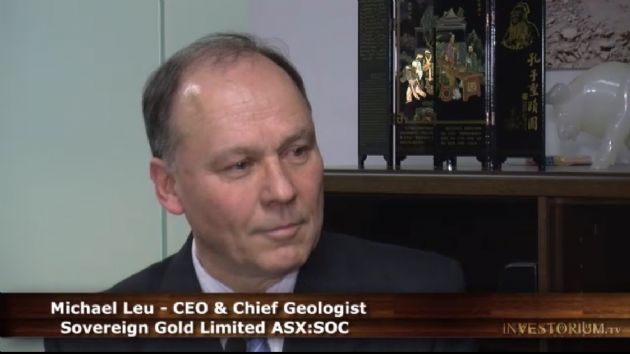 Hobbs Pipe Gold Mineral Resource Update Additional Information
Hobbs Pipe Gold Mineral Resource Update Additional Information
Sydney, Dec 27, 2013 AEST (ABN Newswire) - Sovereign Gold Company Limited (Sovereign Gold) ( ASX:SOC) is providing additional information at the request of the Competent Person related to the Mineral Resource which was previously reported on the 12 December 2013, "Hobbs Pipe - Mineral Resource Update".
ASX:SOC) is providing additional information at the request of the Competent Person related to the Mineral Resource which was previously reported on the 12 December 2013, "Hobbs Pipe - Mineral Resource Update".
An error has been identified by the Competent Person in the tabulation of the Mineral Resource. The base of the Mineral Resource reported on the 12 December 2013 was to a depth of 900 m below surface. This revised Mineral Resource estimate is reported to a depth of 700 m below surface. The original inclusion of the additional 200 m vertical metres is part of the tabulation error. Mineralization is known to be continuous from 700 m to 900 m below surface, and open beyond 900 m below surface. However at present there is insufficient data available to demonstrate with confidence that mineralization below 700 m depth has reasonable prospects for eventual economic extraction and hence be reported as part of the Mineral Resource.
No information relevant to the estimation process, which is outlined in the attached Table 1 for reporting in accordance with the JORC Code, or input data, has been modified from that previously reported on 12 December 2013.
The updated Mineral Resource estimate is 770,000 ounces gold, from a total Mineral Resource estimate of 20.5 Mt at 1.1 g/t gold, at various cut-off grades.
---------------------------------------------------------Classification Material COG Au Tonnage Au Au (g/t) (Mt) g/t) (oz)---------------------------------------------------------Indicated (Surface to 150m depth) Oxide 0.4 0.6 0.9 18,000Indicated (Surface to 150m depth) Primary 0.9 3.0 1.0 96,000Indicated (150m-700mbelow surface) Primary 0.9 8.5 1.2 320,000---------------------------------------------------------Total Indicated 12.1 1.1 440,000---------------------------------------------------------Inferred (Surface to 150 m depth) Primary 0.5 0.2 0.6 39,000Inferred (150m-700m below surface) Primary 0.9 8.2 1.1 290,000---------------------------------------------------------Total Inferred 8.4 1.1 330,000---------------------------------------------------------Total 20.5 1.1 770,000---------------------------------------------------------
Notes:
1 The Mineral Resource is reported in accordance with the JORC Code, 2012.
2 All Mineral Resource tonnes have been rounded to the nearest 100,000 tonnes.
3 Ounces have been rounded to two significant figures.
4 COG is an abbreviation for cut-off grade.
5 Top cut / top cap of 5 g/t gold has been used to reduce 8 composited samples to 5 g/t gold.
6 The Mineral Resource has been reported with a 0.4 g/t gold cut-off grade for oxide material and 0.5 g/t gold cut-off grade for primary material, from surface to a depth of 150 m below surface. From 150 m below surface to 700 m below surface a higher cut-off grade of 0.9 g/t gold has been used. The different cut-off grades used take into account potential for use of different mining methods and oxidation states of the mineralization. A mining concept study has commenced to better define possible mining methods.
Geology
The Mount Adrah Gold Project is a Mesozonal to Epizonal Intrusion-Related Gold System (IRGS) in a dilational zone located along the Gilmore Suture on the edge of a buried pluton, see Figure 1. The deposit is a structurally controlled micro-breccia within a diorite body that intrudes to the current topographic surface. The mineralization in Hobbs Pipe is predominantly monzodiorite-hosted disseminated gold in arsenopyrite and pyrite, and also native gold in stockwork quartz veins. A cross section is shown in Figure 2 and an isometric view in Figure 3. Figure 4 is an oblique cross section and drillhole location plan.
Interpretation
All data available has been used to complete the interpretation which has been undertaken in plan view on 20 m spaced plans. Digital strings representing the mineralized Hobbs Pipe sharp lithological contacts were made and snapped to the drillholes. The mineralized Hobbs Pipe is roughly circular in outcrop and becomes elliptical at a depth of 500 m below surface, where the dimensions are interpreted to be approximately 180 m by 160 m in diameter.
A three-dimensional base of oxidation surface has been created from the geological logging information.
Drilling technique, sub-sampling and analysis
Drilling data used in the interpretation and estimation consists of historic and recent drillholes. Drill data varies in spacing from 20 m x 20 m to 200 m x 200 m in plan view. The drill core from recent drilling has been sampled in 2 m intervals downhole honouring the lithological contacts. Historic data has been sampled in 1 m intervals downhole. Drilling methods include diamond, reverse circulation and percussion. The recent diamond drilling is un-oriented PQ3 size drillhole near the collar with HQ3 triple tube oriented diamond core for the remainder of the drillhole. Diamond drilling has a sample recovery of 99%. Half diamond core has been submitted for analysis to an accredited laboratory. Analytical methods used include fire assay and screen fire assay for gold, and ICP-AES and ICP-MS for multi-element analysis. The historic reverse circulation and percussion drillhole data represent only approximately a quarter of the drill database. Full details of the historic sampling programmes are not available.
Estimation method
A three-dimensional solid was made by wire framing the 20 m spaced plan digital strings. This was filled with parent cells of 20 m x 20 m x 10 m with a minimum sub-cell size of 4 m x 4 m x 2 m. The block model was coded using the base of oxidation surface, oxide domain (above the oxidation surface) or primary domain (below the oxidation surface). Variograms where generated which showed continuity in all directions within the Hobbs Pipe.
Investigation into the possible vertical grade layering identified in the variograms is ongoing. A two-structured spherical variogram was generated and used in an ordinary kriged estimation. Estimation was into parent cells with a discretisation of 4 x4 x 2. An octant search was used requiring four octants to be filled. The search used a minimum of 4 samples and a maximum of 18 samples from a minimum of three drillholes. The first search pass was 80 m x 100 m x 50 m, the same ratio as the variogram ranges, with a rotation of -25, 0, -85, Z, Y and X directions. The second search pass was double the first and the third search pass was triple the original search.
Classification criteria, cut-off grade and modifying factors
The Mineral Resource classification criteria used drill hole spacing as a proxy for confidence in the geological and grade continuity.
Cut-off grades used are based on:
- Proximity of mineralization to surface.
- Potential mining methods.
- Assumed processing and recovery values based on preliminary test work.
Surface to 150 m depth
Surface is variable between 395 mRL and 420 mRL. 270 mRL is approximately 150 m below surface. Below this, it may no longer be possible based on the amount of waste which would be required to be moved to access the mineralization by open pit mining.
Where the drilling is more densely spaced, from surface to a depth of 150 m, the Mineral Resource has been classified as an Indicated Mineral Resource for the:
- Oxide domain, where the grade is greater 0.4 g/t gold.
- Primary domain, where the grade is greater than 0.9 g/t gold.
Both of these areas are geologically continuous zones of material which do include some material below the cut-off grade.
In the primary domain where the drilling is more densely spaced, a shell has been generated to confine a zone of lower grade material at a 0.5 g/t gold cut-off. This has been classified as an Inferred Mineral Resource, due to the lower confidence in the continuity of the lower grade material.
The cut-off grades and depths selected for the classification to 150 m depth are based on:
- Potential open pit mining.
- Mineralization out cropping.
- Gold price of A$1,300 per ounce.
- Processing of refractory mineralization using multiple processing methods.
150 m to 700 m below surface
From 150 m depth to 700 m below surface (270 mRL to a depth of -280 mRL) a classification wireframe shell has been generated around the close spaced drilling. Inside the shell is an Indicated Mineral Resource at a 0.9 g/t gold cut-off grade. Outside this shell is an Inferred Mineral Resource at a 0.9 g/t gold cut-off grade. Both of these are geologically continuous zones which contain some grade below the 0.9 g/t gold cut-off. This cut-off grade and the classification selected is based on:
- Potential underground mining using a smaller scale bulk mining method.
- There is reasonable grade continuity up to 1.2 g/t gold.
- Grade continuity deteriorates rapidly at around 1.5 g/t gold.
Below 700 m from surface
All material below 700 m depth has not been included in the Mineral Resource as there is insufficient data available to demonstrate with confidence that mineralization below 700 m depth has reasonable prospects for eventual economic extraction.
A conceptual mining method study has commenced and further drilling is planned both for Hobbs Pipe and for nearby targets of interest. This additional work will aid in establishing values with which to update the classification criteria going forward.
To view full JORC Code classification and figures, please visit:
http://media.abnnewswire.net/media/en/docs/ASX-SOC-776203.pdf
About Sovereign Gold Company Limited
 Sovereign Gold Co Ltd (ASX:SOC) is an Australian-based specialist gold exploration company. Sovereign Gold has a portfolio of quality tenements located in Eastern Australia where there is known potential for the occurrence of Intrusion-Related Gold Systems (IRGS). Sovereign Gold has a highly prospective tenement package covering the Rocky River-Uralla Goldfield, 21km southwest of Armidale, NSW, Australia. Sovereign owns the recent Mt Adrah Hobbs IRGS discovery south-east of Wagga Wagga, NSW.
Sovereign Gold Co Ltd (ASX:SOC) is an Australian-based specialist gold exploration company. Sovereign Gold has a portfolio of quality tenements located in Eastern Australia where there is known potential for the occurrence of Intrusion-Related Gold Systems (IRGS). Sovereign Gold has a highly prospective tenement package covering the Rocky River-Uralla Goldfield, 21km southwest of Armidale, NSW, Australia. Sovereign owns the recent Mt Adrah Hobbs IRGS discovery south-east of Wagga Wagga, NSW.
![abnnewswire.com]()
Related Companies
Social Media
Share this Article

 ASX:SOC) is providing additional information at the request of the Competent Person related to the Mineral Resource which was previously reported on the 12 December 2013, "Hobbs Pipe - Mineral Resource Update".
ASX:SOC) is providing additional information at the request of the Competent Person related to the Mineral Resource which was previously reported on the 12 December 2013, "Hobbs Pipe - Mineral Resource Update". Sovereign Gold Co Ltd (ASX:SOC) is an Australian-based specialist gold exploration company. Sovereign Gold has a portfolio of quality tenements located in Eastern Australia where there is known potential for the occurrence of Intrusion-Related Gold Systems (IRGS). Sovereign Gold has a highly prospective tenement package covering the Rocky River-Uralla Goldfield, 21km southwest of Armidale, NSW, Australia. Sovereign owns the recent Mt Adrah Hobbs IRGS discovery south-east of Wagga Wagga, NSW.
Sovereign Gold Co Ltd (ASX:SOC) is an Australian-based specialist gold exploration company. Sovereign Gold has a portfolio of quality tenements located in Eastern Australia where there is known potential for the occurrence of Intrusion-Related Gold Systems (IRGS). Sovereign Gold has a highly prospective tenement package covering the Rocky River-Uralla Goldfield, 21km southwest of Armidale, NSW, Australia. Sovereign owns the recent Mt Adrah Hobbs IRGS discovery south-east of Wagga Wagga, NSW.











